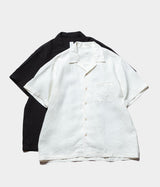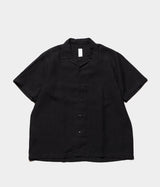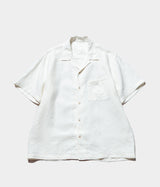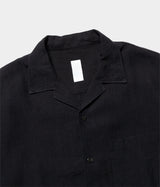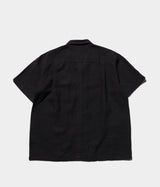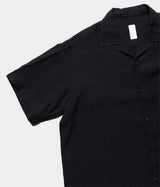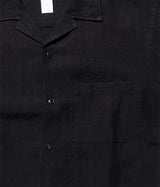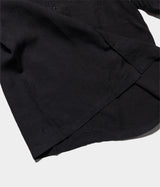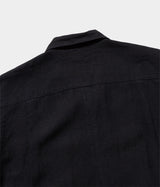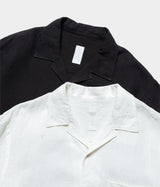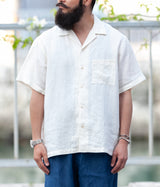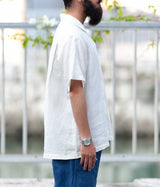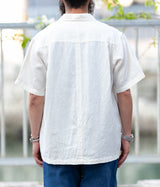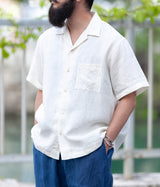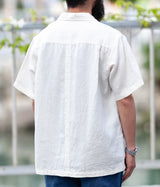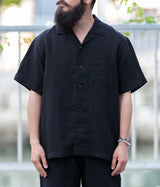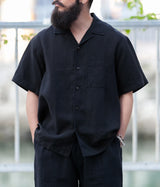SENUI
A vertical line in the center of the back.
In kimono and tailored clothing
the technique of sewing the left and right fabrics together at the center of the back, called "backstitching"
It is not only a technique
but also a crystallization of culture
but also a crystallization of culture
to tailor valuable clothes.
Designer: Hiroyuki Kato
Kato started senui, a shirt brand, in 2022 based on his experience in production and planning for domestic and international shirt brands. He handles everything from design to pattern and sewing by himself. He researches various shirts and vintage items from Japan, the U.S., and Europe, and proposes a new way of making shirts.
"S/S Shirt"
This short-sleeved shirt is a collaboration between SENUI and SOUTH STORE.
The silhouette is a relaxed box shape to suit the Okinawan climate, and can be worn lightly because there are no seams on the sides. The collar is an open collar with a three-dimensional finish to prevent it from becoming too casual.
The fabric is made of 40/1 linen woven in Hamamatsu, Shizuoka Prefecture. The linen is plain-weave linen that can be expressed only with Japanese techniques, and is finished from dyeing to texture at a factory in Kyoto. The natural washer finish gives the linen its original cool and crisp feel, and the sun-dried texture is characterized by its crinkled texture and natural-looking wrinkles.
Backstitching:
The usual side seams are eliminated, and the fabric is sewn together only at the back. Because there are no side seams, the fabric naturally falls to the sides. The yoke is designed as a split yoke so that the seam line runs lengthwise neatly down the back.
Stitching:
22 stitches per 30mm
22 fine stitches with 30mm spacing. The stitch count for a normal shirt is 15~18 stitches per 30mm, and for a dress shirt, 21~22 stitches are required.
Yarn:
All yarn is 60 count cotton yarn.
All cotton yarns are 60 count. When the vintage products were produced, the factory equipment was completely different from that of today, the biggest difference being that the old sewing machines were foot-pedal and the sewing thread was cotton thread. The most significant difference is that the old sewing machines were foot-pedal and the sewing threads were cotton threads, which are very compatible with natural fiber fabrics and also produce a unique puckering. They also work very well with linen fabrics. (Today's sewing machines are equipped with high-speed industrial motors, and sewing threads are made of polyester to withstand such motors, making it very difficult to sew with cotton thread. ) The shirts are sewn with cotton thread with fine stitches, just like the shirts sewn in the early 1900s, to achieve the texture that vintage shirts have. With long wear, the cotton threads will derive shrinkage due to the cotton threads, creating a beautiful puckering.
Collar:
Thin and soft 100% cotton flap core is used.
Buttons:
Natural shell buttons.
Natural shell buttons are used. The black buttons are made of black butterfly shells, and the side that usually comes on the back is used on the front. The buttons have a horn-like texture.
Brand tag
The brand tag is inspired by a hanging scroll of an ink painting. The seal is made of white and light gray threads, although you have to look closely to perceive the level of detail. The brand logo is made by assembling the characters vertically, as in Japanese, a language with vertical writing, which is rare in the world. The material used is Bemberg, a recycled fiber made from cotton.
Size (cm)
S / Length 73, Shoulder width 50, Sleeve length 25, Body width 63
M / Length 75 Shoulder width 52 Sleeve length 26 Body width 66
Wearing model: 174cm, size: S
Material : 100% Linen
Made in Japan
A vertical line in the center of the back.
In kimono and tailored clothing
the technique of sewing the left and right fabrics together at the center of the back, called "backstitching"
It is not only a technique
but also a crystallization of culture
but also a crystallization of culture
to tailor valuable clothes.
Designer: Hiroyuki Kato
Kato started senui, a shirt brand, in 2022 based on his experience in production and planning for domestic and international shirt brands. He handles everything from design to pattern and sewing by himself. He researches various shirts and vintage items from Japan, the U.S., and Europe, and proposes a new way of making shirts.
"S/S Shirt"
This short-sleeved shirt is a collaboration between SENUI and SOUTH STORE.
The silhouette is a relaxed box shape to suit the Okinawan climate, and can be worn lightly because there are no seams on the sides. The collar is an open collar with a three-dimensional finish to prevent it from becoming too casual.
The fabric is made of 40/1 linen woven in Hamamatsu, Shizuoka Prefecture. The linen is plain-weave linen that can be expressed only with Japanese techniques, and is finished from dyeing to texture at a factory in Kyoto. The natural washer finish gives the linen its original cool and crisp feel, and the sun-dried texture is characterized by its crinkled texture and natural-looking wrinkles.
Backstitching:
The usual side seams are eliminated, and the fabric is sewn together only at the back. Because there are no side seams, the fabric naturally falls to the sides. The yoke is designed as a split yoke so that the seam line runs lengthwise neatly down the back.
Stitching:
22 stitches per 30mm
22 fine stitches with 30mm spacing. The stitch count for a normal shirt is 15~18 stitches per 30mm, and for a dress shirt, 21~22 stitches are required.
Yarn:
All yarn is 60 count cotton yarn.
All cotton yarns are 60 count. When the vintage products were produced, the factory equipment was completely different from that of today, the biggest difference being that the old sewing machines were foot-pedal and the sewing thread was cotton thread. The most significant difference is that the old sewing machines were foot-pedal and the sewing threads were cotton threads, which are very compatible with natural fiber fabrics and also produce a unique puckering. They also work very well with linen fabrics. (Today's sewing machines are equipped with high-speed industrial motors, and sewing threads are made of polyester to withstand such motors, making it very difficult to sew with cotton thread. ) The shirts are sewn with cotton thread with fine stitches, just like the shirts sewn in the early 1900s, to achieve the texture that vintage shirts have. With long wear, the cotton threads will derive shrinkage due to the cotton threads, creating a beautiful puckering.
Collar:
Thin and soft 100% cotton flap core is used.
Buttons:
Natural shell buttons.
Natural shell buttons are used. The black buttons are made of black butterfly shells, and the side that usually comes on the back is used on the front. The buttons have a horn-like texture.
Brand tag
The brand tag is inspired by a hanging scroll of an ink painting. The seal is made of white and light gray threads, although you have to look closely to perceive the level of detail. The brand logo is made by assembling the characters vertically, as in Japanese, a language with vertical writing, which is rare in the world. The material used is Bemberg, a recycled fiber made from cotton.
Size (cm)
S / Length 73, Shoulder width 50, Sleeve length 25, Body width 63
M / Length 75 Shoulder width 52 Sleeve length 26 Body width 66
Wearing model: 174cm, size: S
Material : 100% Linen
Made in Japan


















